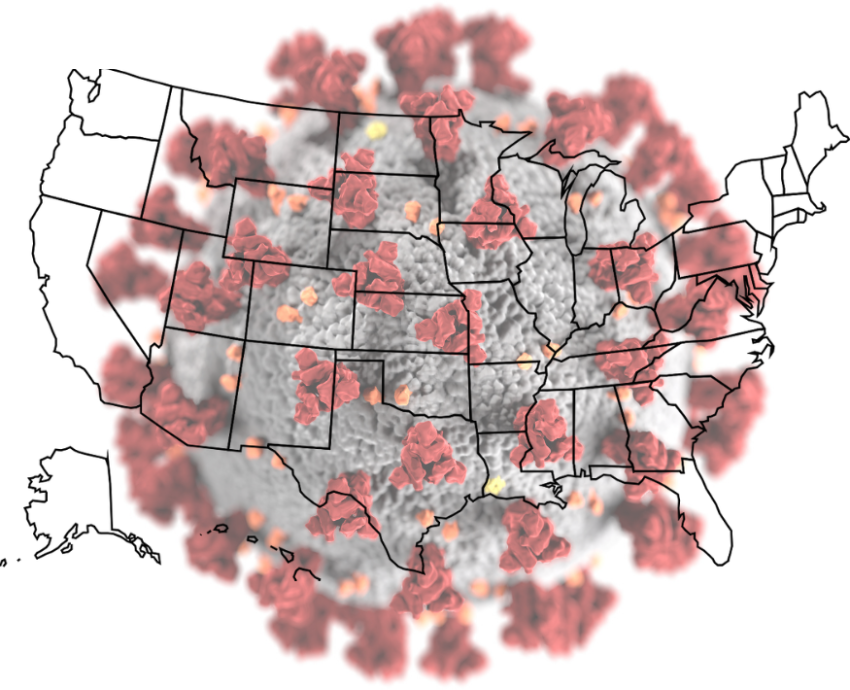
The accelerating upsurge in COVID-19 infections in the United States has reached more than 170,000 a day, well above last summer’s peak of 63,000 a day.
Infections surged to a one-day record of 184,000 on November 13. In one week, the number of cases since the pandemic began went from 10 million to 11 million.
Texas and California have each passed more than 1 million total cases.
For the first time all areas of the US are affected.
This new wave is growing fast and shows no indication of slowing down.
Hospitalisations, which lag behind cases, have reached 70,000, ten thousand more than in the summer peak.
Deaths are now at 1400 a day. This is less than the daily rate of 2200 reached in March-April, due to medical workers and drug companies learning from experience how to better care for hospitalised patients. However, deaths are expected to reach new highs, as hospitalisations soar.
According to the New York Times, in El Paso, Texas “there have been so many deaths in recent days that the county medical examiner parked five mobile morgue units — the size of trucks — outside its doors.”
Experts foresee a “horrifying” toll in coming months, according to the NYT. Hospitals are reaching capacity in some regions. Even the best medicines and techniques lose their usefulness if too many people get sick at the same time, taxing staffing and supplies.
“When you’ve overwhelmed the health care system, nobody is going to get optimal care,” Dr Jessica Justman, an epidemiologist at Columbia University, told the NYT.
A new survey by National Nurses United found that hospitals are still failing to provide adequate personal protective equipment and workplace protections.
Nurses say hospitals are unprepared for the surge to worsen during the flu season. Nurses also report mental health struggles from the stress of dealing with so many patients, and the danger of becoming infected, according to Democracy Now!.
One cause of this new upsurge was the relaxation of restrictions on social distancing, using masks when in public places, and large public gatherings. This was exacerbated by Donald Trump’s refusal to advocate these policies, resulting in Republican-led states and local governments ignoring them. Most of his tens of millions of followers did the same.
There are reports of some patients — Trump believers — dying of COVID-19 in hospitals, while refusing to believe that the virus was killing them, angrily saying to doctors and nurses that there is no such virus.
Now, many states, but not all, are re-imposing restrictions on businesses where people congregate. There may have to be new lockdowns. But, unless enough of the states, local governments and the population comply, the new upsurge will not begin to be brought down.
In the best of cases, that will take months.
New vaccines, based on technology using the virus’s genetic RNA, report encouraging initial findings from mass testing, with more than 90% effectiveness.
They still have to be assessed for safety, before they can be certified. When they are, a small amount will be used first on medical personnel and vulnerable populations, on an emergency basis, the Trump administration says.
However, this projection faces many hurdles, and the task of inoculating the whole population faces even more.
Assuming the vaccine can be deployed for emergency use by year’s end, compared to the billions the Trump administration has showered on drug companies, “the logistics of inoculating and tracking as many as 20 million people by year’s end — and many tens of millions more next year" have been largely left to local governments without adequate funds, according to officials and health experts who spoke to the NYT.
“Public health departments, already strained by a pandemic that has overrun hospitals and drained budgets are racing to track and share information about who has been vaccinated; to recruit and train thousands of doctors, nurses and pharmacists to give people the shot and collect data about everyone who gets it; to find safe locations for mass vaccination events; and to convince the public the importance of getting immunised,” said the NYT.
According to the NYT, “the federal Centers for Disease Control and Prevention (CDC) have sent $200 million to the states for the effort, with another $140 million promised in December, but state and local officials said that was billions of dollars short of what would be needed to carry out their complex plans.” Estimates are that $6–8 billion will be needed.
There are myriad other costs, including paying for secure convoys to transport the vaccine within states.
There are many companies involved, including makers of syringes and other medical equipment, all of which have to be coordinated.
Moreover, the first vaccine developed by Pfizer, which the administration has already paid billions to manufacture, requires two shots, weeks apart, meaning additional records and follow-up.
Moreover, this vaccine needs to be kept at -75°C, a logistical difficulty in itself. Another vaccine developed by Moderna can be kept at -20°C, so would not face that hurdle, but which vaccine will be deployed has not been announced.
The billions necessary to carry out the first emergency use will not likely be allocated by December, given Republican opposition in the Congress.
It will take many months, at least to the end of next year, for a vast program of vaccinations of the entire US population — the largest, by far, in US history.
It also is not known how long a vaccination will remain effective. Will it be like the flu vaccination — six months — requiring another mass vaccination then? The flu season only lasts from autumn to spring. COVID-19 is infectious year round.
So a vaccine will not be a silver bullet, obviating the need for implementing what we know works: masks, social distancing and no large gatherings.